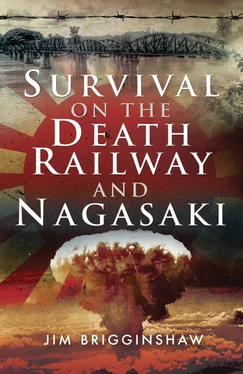With the better diet at Tamarkan, strength gradually returned to the prisoners. However, even though they had more to eat, they couldn’t resist eyeing off the Japanese commandant’s private supply of hens, ducks and goats. This commandant, like those at every prisoner-of-war camp, had his own source of live food.
In charge of the commandant’s livestock at Tamarkan was the Korean guard the prisoners had christened Blubber Lips in Burma. He and the other guards were the same vicious lot that had plagued the prisoners on the Death Railway.
Blubber Lips had plenty of brawn, but not much brain. Still, he was smart enough to get other people to do his dirty work for him. Each day, he’d have a couple of prisoners collect eggs, milk the goats, clean out the pens and feed and water the poultry and goats.
If Blubber Lips had had more brains, he would have figured out why there was never any shortage of volunteers for the jobs. While he lazed in the shade, the egg collectors would be sucking eggs and the goat milkers would be swallowing milk. To replace the milk that was consumed, water would be added to the pail so that Blubber Lips never noticed that any was missing. If he questioned the shortage of eggs, the men blamed the hens. When they did, Blubber Lips would grab the nearest hen by the neck and give the poor bird a sound talking-to for not working harder.
Strangely, while he took it out on the hens, he never suspected his workers.
To display their Oriental superiority, the Japanese and Korean guards at Tamarkan arranged a soccer match against the prisoners, believing that the Australians played a different football code and would have little knowledge of the round-ball game.
The prisoners recruited a couple of Brits who’d played it back home and could show them what was needed.
Finding a referee was difficult. Penalising the guards for rules infringements would be extremely dangerous. A gallant Scot, Sergeant Jock Strang from an Argyle and Sutherland unit, finally took on the job.
The game started with the prisoners bowling over the opposition using tackles that would never make the soccer manual. The Japanese and Koreans howled that this was foul play. The ref listened earnestly to their protests, knowing that while they were busy complaining, the prisoners were scoring goals. By half-time, they had a big lead, and the Japanese were slapping the ref around over his rulings.
During the break, he suggested to the prisoners that it would be safer for him, and them, if they let the guards win.
The second half saw an incredible comeback by the guards. By the final whistle, they were well in front and in a happy mood, having proven their superiority. It was important to them to be seen as superior.
This need to be superior was their reason for having the prisoners salute and bow to them. This was in evidence whenever work parties were entering or leaving the camp. The officers in charge of the workers were required to give the order ‘Me ga migi (eyes right)’ in Japanese as they passed the guardhouse and saluted the guards.
One big American marine sergeant from the USS Houston told his group, ‘They ain’t going to make me speak this Jap shit.’ As his party passed the guardhouse, he’d salute and yell at the top of his voice, ‘Take a look at those guys.’ When they’d passed the Japanese, he’d yell, ‘Stop looking at those guys.’
The guards, even if they knew what he yelled, took no action. He’d saluted, and that satisfied them. It was only a small moral victory, but it was enough for the Australian prisoners to start giving their own salute, a thumb to the point of the nose with fingers outstretched.
The guards accepted this time-honoured Aussie gesture as a mark of respect. They never found out that it meant something far removed from respect.
The Tamarkan guards were particularly dangerous when they were drunk. One afternoon, a party of them arrived back in camp full of sake and hell-bent on trouble. Singing at the tops of their voices, they staggered into the shed where Bodero’s work party was cutting wood for the fires, grabbed the axes from them and started swinging. The prisoners quickly cleared out.
Left with nobody to hit, the guards, still waving the axes, moved on to a hut occupied by Dutch prisoners, which also emptied quickly.
The guards were too drunk to do any damage and eventually collapsed one by one. Only then were the woodcutters able to retrieve their axes.
The Tamarkan prisoners showed amazing ingenuity and skill. They restored charcoal-fuelled gas producers and used them to run refrigerators discarded by the Japanese because gas supplies were unobtainable.
With the refrigerators working again, the men had somewhere to store food for the sick in the camp hospital. The Japanese were kept in the dark about the refrigerators being brought back to life.
Now the medicines the prisoners made from the limited materials available were able to be kept under refrigeration. One of these was a yeast made from fruit peelings. The yeast had a high vitamin content and was a valuable additive to the diet of the sick.
More and more prisoners were feeling the effects of the long period of suffering, and some went mad. One young Australian, mentally deranged after a cerebral haemorrhage, threw himself down a well.
He was rescued by his mates and taken back to the camp hospital. They sat with him during the night, but when they fell asleep, he left the hospital and was crossing the bridge over the river when he was seen by a Japanese guard. Ordered to stop, he continued across the bridge, whereupon the guard bayoneted him several times. Seriously wounded but still alive, the boy was returned to the hospital where the Japanese, when they learnt he was insane, did all they could to save his life, even to the extent of obtaining blood plasma for a transfusion. However, despite their efforts to save him, the boy died.
The compassion shown to him by guards known more for their inhumane treatment was explained by a strange facet of the Japanese psyche. They respected insanity, or perhaps feared it, and would never mistreat a madman. When the prisoners learned this, there was a sudden outbreak of insanity in the camp.
Tamarkan prisoners were allowed to have cooking fires. They had lights in their huts and could smoke if they had tobacco, but not after lights out at nine o’clock.
The no-smoke-after-nine edict came about because at that time every night, Allied planes flew over the camp on their way from India to bomb Saigon and other targets, and the Japanese feared that lit cigarettes would be seen from the air.
One night, Jim Bodero and nine other prisoners who shared the twenty-foot-long sleeping platform were having a group natter when an Australian officer came in and told them it was lights out.
A guard rushed in past the officer bellowing ‘Who smoke? Who smoke?’
The prisoners told him no one had been smoking.
‘ Nippon see smoking, Nippon see’, the guard shouted. ‘All men out!’
The ten prisoners were lined up outside the hut and told to number off. The guard made each man breathe into his face. When that failed to produce any smell of smoke, he sniffed their hands. Still nothing.
The prisoners really believed that none of them had been smoking. A few days later, Snowy Baker admitted that he was the guilty party. When the Australian officer had told them it was lights out, he’d squeezed the end of his cigarette and the sparks that had fallen from it through the bamboo slats to the ground had been seen by the guard, who’d been outside the hut.
The guard, when his smell-testing could find no incriminating evidence, ordered the guilty man to own up. Nobody did.
The ten men were marched to the guardhouse and lined up. The guard commander called the prisoners to attention and made them number off again. Then he said, ‘Nippon guard say one man smoke. Who smoke?’
Читать дальше












